| Author |
Message |
|
Greg M
Location: Alberta Joined: 13 Aug 2011
Posts: 7
|
 Posted: Wed 18 Apr, 2012 4:47 am Post subject: Help with Wisby Era Harness Posted: Wed 18 Apr, 2012 4:47 am Post subject: Help with Wisby Era Harness |
 |
|
Hello again all, it has been awhile. I have been attempting to piece together a Wisby or a mid to late 14 century harness. I am torn between making my own brigadine and coat of plates or using plate armor. I was hoping someone could advice me on some reliable armorers. All the pieces need to be strong enough for practical use and need to be historically accurate to the above mentioned era. Any help is appreciated
Here is an example of a plate harness

|
|
  |
 |
Randall Moffett

|
 Posted: Wed 18 Apr, 2012 6:34 am Post subject: Posted: Wed 18 Apr, 2012 6:34 am Post subject: |
 |
|
I am assuming you are going for living history/historically correct type of harness.
There is a great deal of change in the 14th century so if you are shooting for Wisby 1361 some of your harness will not work.
The type of visor on your bascinet is a bit early for 1361. You might be able to use the bascinet without the visor though and create a earlier model.
The breast plate works. By the 1360s solid one piece breastplates are increasingly common.
Articulated arms and legs come in during the mid 14th as well but most of the cuisses of this period look to be of splint make but it might be OK. If you have more pictures of the armour by itself might help as I cannot see some of the characterisitcs I normally look for.
Hourglasses come in mid 14th but might be a bit early for a man who is not of wealth.
Your spaulders need to have the lames removed cut down quite a bit and reattached. Think 1-1.25" in total with 1/4" overlap. Some shaping on them to match the spualder cop would be a good idea as well.
If you are a knight and by your gear seems you are you need a surcoat/coat of arms as well.
Hope this gets your started.
RPM
|
|
  |
 |
|
Thomas Peters
Location: La Farge, WI Joined: 19 Oct 2011
Posts: 27
|
 Posted: Wed 18 Apr, 2012 9:39 am Post subject: wisby harness Posted: Wed 18 Apr, 2012 9:39 am Post subject: wisby harness |
 |
|
Greg,
I have a Brigandine from Steel Mastery that is patterned after a Wisby grave find. It is made quite well with 14 gauge (2mm I think) plates, sewn leather straps, flax linen liner, wool outer shell and came with a small repair kit. It has stood up well for me, but if you are going to be doing rebated steel fighting I would suggest getting the leather outer shell. I think the leather would be more durable to the abuse than the wool is.
Steel Mastery is out of the Ukraine and I have had positive experience with them although the delivery of the Brigandine was delayed several months from the original date given.
I do not have a picture to post but will try to get one up for you to look at.
Tribe Woden Thor historical re-enactors.
|
|
   |
 |
Björn Hellqvist
myArmoury Alumni


|
 Posted: Wed 18 Apr, 2012 3:51 pm Post subject: Posted: Wed 18 Apr, 2012 3:51 pm Post subject: |
 |
|
There was a reenactment last year, held in the original location 650 years after the real battle. You can find a crapload of photos here; it will give you a good idea what to aim for.
My sword site
|
|
   |
 |
|
Greg M
Location: Alberta Joined: 13 Aug 2011
Posts: 7
|
 Posted: Wed 18 Apr, 2012 4:58 pm Post subject: Posted: Wed 18 Apr, 2012 4:58 pm Post subject: |
 |
|
Thank you for the replies,
Radall the harness pictured is not mine it is one of the members of the living history group. I may be trying to be too specific with just Wisby the group focuses of the mid to late 14th century. Basically the time of Edward the black Prince. Looking at various effigies it seems little a very mottled time. The transition from mail to plates, basinets with visors and even great helms with visors.
|
|
  |
 |
Randall Moffett

|
 Posted: Wed 18 Apr, 2012 6:51 pm Post subject: Posted: Wed 18 Apr, 2012 6:51 pm Post subject: |
 |
|
Greg,
Depends what you are doing. If you are a knight or higher level in society you will have largely a full harness of plate by the second half of the 14th. There are some evidences that some did not but the bulk of them followed this trend.
Splinted armour is largely on its way out by the end of the 3rd quarter of the 14th century though you see in some regions like central and eastern Europe it lingers. If you plan on doing these areas you should find out which areas were and were not. I am not really a specilist in local or regionial trends like this as there are just too many to know.
Prince Edwards life starts in June 1330 (around the time Edward III takes roger Mortimer out) and the Prince dies June 1376. So you basically cover the middle two quarters of the 14th century if that is your groups period of cover. The first half of the 14th century is where much of the transition takes place.The second is simply building upon this and proliferation.
If you are doing Prince Edward's life as a period then you have very much part of the transition so mail, textile (aketon and gambesons), splint, full plate and such are all open to you.
If you want to do a Wisby harness it fits well within your time frame.
RPM
|
|
  |
 |
|
Jojo Zerach
|
 Posted: Wed 18 Apr, 2012 8:28 pm Post subject: Posted: Wed 18 Apr, 2012 8:28 pm Post subject: |
 |
|
I'm not trying to knock the harness in your photo (or it's owner), but it isn't that historically accurate, and I wouldn't suggest using it as a guide.
(The most notable issues being the lack of a jupon, and the separate SCA-style spaulders.The frontal greaves also don't really go with articulated legs.)
|
|
  |
 |
|
Henrik Granlid
|
 Posted: Thu 19 Apr, 2012 12:48 am Post subject: Posted: Thu 19 Apr, 2012 12:48 am Post subject: |
 |
|
To further the talk about the harness.
14th Century gear DID strive for the hourglass look in all aspects, although large hourglass gloves came in toward the late end.
By "Hourglass look", I am reffering to the chest here, they weren't full-body, they were, instead, rounder, and covered only the chest, leaving the abdomen to be protected by chainmail and gambeson.
One example of a late 14th century "low"-nobleman-suit-of-armour:
http://histvarld.historiska.se/draekter/1300sladel/index.html
(click the blue links under the picture for further pictures of the helmet, gloves, plate etc.)
|
|
  |
 |
|
Mikael Ranelius
|
 Posted: Thu 19 Apr, 2012 1:32 am Post subject: Posted: Thu 19 Apr, 2012 1:32 am Post subject: |
 |
|
|
Since most of the findings excavated at the Visby mass graves are thought to have belonged to slain Gotlanders, the various pieces of armour would have been considered outdated by 1361, at least in terms of fashion. The square mail coifs and several coat of plates reflect early 14th or even late 13th century military fashion, whereas the gauntlets could be dated to anywhere between the early to mid 14th century.
|
|
  |
 |
|
William P
|
 Posted: Thu 19 Apr, 2012 3:22 am Post subject: Posted: Thu 19 Apr, 2012 3:22 am Post subject: |
 |
|
| Mikael Ranelius wrote: | | Since most of the findings excavated at the Visby mass graves are thought to have belonged to slain Gotlanders, the various pieces of armour would have been considered outdated by 1361, at least in terms of fashion. The square mail coifs and several coat of plates reflect early 14th or even late 13th century military fashion, whereas the gauntlets could be dated to anywhere between the early to mid 14th century. |
one indication of the outdated nature of the gotlandic armour was the famous wisby 'lamellar' which was one of the armour suits found at wisby
this was lamellar in the full sense of the word... and there are examples of lamellar suits with plates shaped like those (i.e half oval) that date to at least the 9th century by people like the avars..
http://www.hoashantverk.se/hantverk/hoas_rust...front.html clearly these were desperate people using old stuff.
it would be like facing oliver cromwells army using an old pole handgonne
reminds me of how napoleons french armies in spain noted spanish partizans were using matchlocks initially..
|
|
   |
 |
|
Sjors B
Location: Zevenaar, The Netherlands Joined: 31 Aug 2011
Posts: 43
|
 Posted: Thu 19 Apr, 2012 5:03 am Post subject: Posted: Thu 19 Apr, 2012 5:03 am Post subject: |
 |
|
Hey Greg.
First of all: i would recomend this book: http://revival.us/armourfromthebattleofwisby.aspx
quit expensive but it should be what you are looking for.
As for reliable armourers, that depends on the price you are willing to pay. Steve from white rose apparel ( http://www.whiteroseapparel.com/brigandines.htm ) makes good quality brigandines, tough he is difficult to get in touch with. One of my teammates has a brigg of his, a beautifull piece of work.
For a lower budget armourers like Pavel marek ( www.armorymarek.com ) and steel mastery (as posted before) make reasonable stuff for a reasonable price.
Kind regards
member of the langenort school for European martial arts in Nijmegen (NL)
http://www.historicalshows.com/
|
|
   |
 |
|
Craig Shackleton
|
|
   |
 |
Björn Hellqvist
myArmoury Alumni


|
 Posted: Thu 19 Apr, 2012 10:19 am Post subject: Posted: Thu 19 Apr, 2012 10:19 am Post subject: |
 |
|
| Mikael Ranelius wrote: | | Since most of the findings excavated at the Visby mass graves are thought to have belonged to slain Gotlanders, the various pieces of armour would have been considered outdated by 1361, at least in terms of fashion. The square mail coifs and several coat of plates reflect early 14th or even late 13th century military fashion, whereas the gauntlets could be dated to anywhere between the early to mid 14th century. |
One of the coats-of-plates sport heraldic buckle mounts (IIRC), indicating that the owner was probably a younger member of a Friesian noble family who went the mercenary route and fought on the Danish side. As the Friesian isles aren't the most abundant farming country, it is possible that the family was minor and not very rich, the c-o-p being handed down to a younger son.
My sword site
|
|
   |
 |
|
Jojo Zerach
|
 Posted: Thu 19 Apr, 2012 11:15 am Post subject: Posted: Thu 19 Apr, 2012 11:15 am Post subject: |
 |
|
| Henrik Granlid wrote: | To further the talk about the harness.
14th Century gear DID strive for the hourglass look in all aspects, although large hourglass gloves came in toward the late end.
By "Hourglass look", I am reffering to the chest here, they weren't full-body, they were, instead, rounder, and covered only the chest, leaving the abdomen to be protected by chainmail and gambeson.
One example of a late 14th century "low"-nobleman-suit-of-armour:
http://histvarld.historiska.se/draekter/1300sladel/index.html
(click the blue links under the picture for further pictures of the helmet, gloves, plate etc.) |
I wouldn't agree that the abdomen was always left to be covered by only mail and a gambeson.
Most effigies from the 1340's show coat-of-plates that come down over the hips. To switch from this to a standalone breastplate, you would be losing a lot of plate coverage.
Coat-of-plates seem to have kept evolving well past the Wisby designs, taking on a slight hourglass shape by the 1350's. By the 1360's, they seem to have evolved in the the armour seen on the St George statue.
http://www.designdestinations.org/wp-content/...G_0977.jpg
(Which shows the same hourglass profile most effigies show covered by a jupon.)
|
|
  |
 |
Randall Moffett

|
 Posted: Thu 19 Apr, 2012 11:27 am Post subject: Posted: Thu 19 Apr, 2012 11:27 am Post subject: |
 |
|
Bjorn,
It is also possible the family sold it decades earlier and it was bought later by some guy in Gotland or Denmark who could only afford second hand armour. Second hand armour was a major trade in and of itself. Just check out Datani, this is how he made his career. Personally I figure many of them were just old. If you look at COPs we can date, the Kussnach and Hirshstein Castle one they are all horizontal by the 1340s. I think we might have some later ones thrown in but figure all the COPs in the pit were Gotlanders as the Danes likely had few casualties.
Jojo,
I agree clearly somre went down lower than the chest. In fact I think most if not all do in the 14th century. Navel seems to be the point where many end. That said one simply needs to have a bend point at the real waist and there is no issue. We see effigies and art that show some of these COPs went down to the hips or even mid thigh but I have no idea what they looked like under the foundation.
RPM
|
|
  |
 |
|
Greg M
Location: Alberta Joined: 13 Aug 2011
Posts: 7
|
 Posted: Fri 20 Apr, 2012 8:54 am Post subject: Posted: Fri 20 Apr, 2012 8:54 am Post subject: |
 |
|
Ideally I would like to join knight with footman. I would like to have the foot man look of splinted armor with coat of plates but I the visored helm depicted below. Guenther von schwarzburg is the closest example
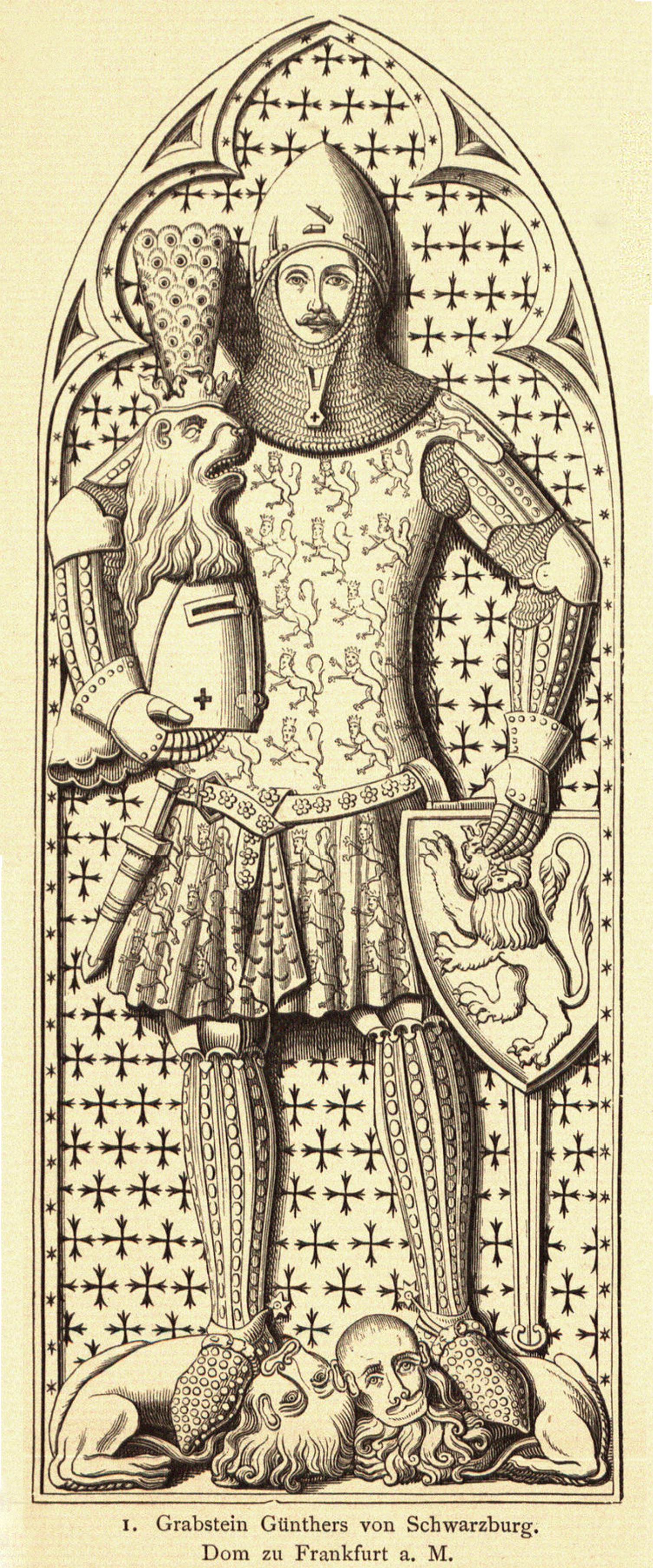
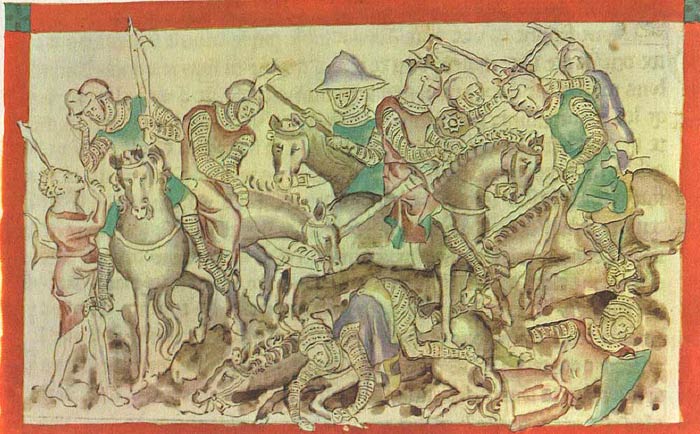
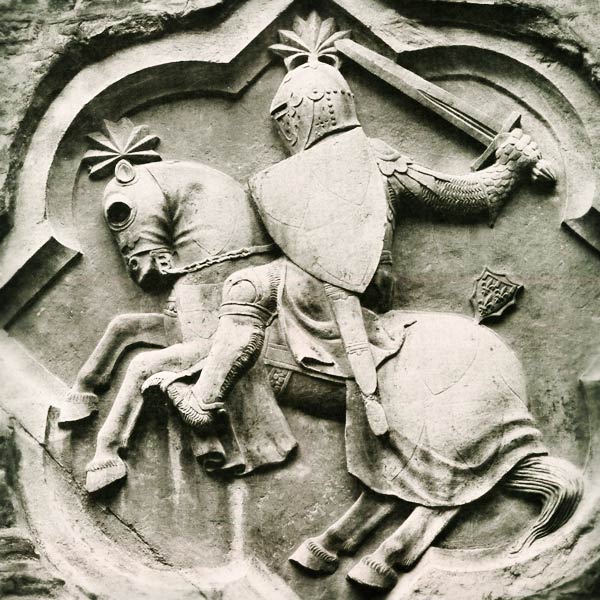

|
|
  |
 |
|
Jojo Zerach
|
 Posted: Fri 20 Apr, 2012 12:31 pm Post subject: Posted: Fri 20 Apr, 2012 12:31 pm Post subject: |
 |
|
That wouldn't be a problem, splinted armour and coat-of-plates were commonly worn with visored helmets.
The visored sugar loaf would have been up to date armour up until about 1320-1330, after that the bascinet becomes nearly universal.
(As was mentioned above, much of the armour unearthed at Wisby would have been up to date in 1290.)
|
|
  |
 |
|
Ryan Harting
|
 Posted: Fri 20 Apr, 2012 1:18 pm Post subject: Posted: Fri 20 Apr, 2012 1:18 pm Post subject: |
 |
|
|
I was actually wondering what the difference in pattern between late 13th and early 14th century coat of plates was. Is it matter of the size and shape of the plates or perhaps a matter of overlap? Merely curious and it seemed on topic.
|
|
  |
 |
Randall Moffett

|
 Posted: Fri 20 Apr, 2012 2:07 pm Post subject: Posted: Fri 20 Apr, 2012 2:07 pm Post subject: |
 |
|
Here is how I am seeing things. Most is based off evidence but there is some gut feeling in here as well as I do not think any one can say for sure.
If you look at 13th century evidence all those I know of are vertical plates. My feeling on the evidence I have seen is the Coat of plates develops to horizontal plates over much of its coverage over time but more toward the 1320s or 1330s. Look at the Romance of Alex from the 1340s for example- all horizontal. It seems likely they coincided for much of the 14th. There is an odd ball that might make the exception. It is also likely there were also some vertical plates that grew smaller and more numerous as with the last type Wisby, which appears more recent than some of the other larger plate vertical ones.
The only evidence we have for not overlapping is the sleeping guard. St. Maurice is impossible to tell but looks to me like it is not separate plates spaced out. The 14th century remains we have all seem to fit best with over lap of the plates.
From a practical point of view vertical and horizontal can be made to work well regardless and over lap makes a huge difference.
RPM
|
|
  |
 |
Mackenzie Cosens

Location: Vancouver Canada Joined: 08 Aug 2007
Posts: 238
|
 Posted: Fri 20 Apr, 2012 6:20 pm Post subject: Posted: Fri 20 Apr, 2012 6:20 pm Post subject: |
 |
|
What area would you like the harness to be from? What will you be using it for? How high a status individual are you try to display?
If you go with plate, you will likely want some kind of jupon or coat to go over the body.
OK this is just for fun its Friday after all:
The Visby armour with the heraldic buckle mounts,Visby armour #7, is a Visby type 1 armour which means that it has horizontal plates on front and vertical plates on the back and sides. The horizontal plates fit with some armour of mid 14th C the vertical plates are what some people use to argue that it is transitional form from vertical to horizontal plates and therefore dated earlier. (Now for a weak counter argument) but Churburg 13 is made of vertical plates and its a much later armour so there are exceptions to general trend to horizontal plates. Personally I think Visby type 1 armours are just likely to be variants, and not some step along an evolutionary COP process.
It is interesting that armour #7 is composed of larger sheets of metal. Larger sheets of metal are harder to come by the earlier you go. I understand that one of the arguments for why breast plates and helmets are the size they are is its how big a lump of iron you can get out the smelting technology you have. So using that argument, larger sheets of metal mean newer not older armour or at least more costly armour. So you have a COP with larger horizontal plates which for arguments sake I will argue indicates a mid 14th C not earlier date. Now if it was made of steel not iron that would be really interesting. 
Visby armour 2 is quite interesting because it appears to be physical very similar to the front of Kussnach 1 which is dated in Thordeman to the second quarter of the 14th C. So if armour 2 and armour 7 are mid 14C types that supports the idea that at least some of the other armours are also mid 14C types, particularly the Visby type 1s . They are not the newest thing from Italy but not obsolete either.
What we do know is that these armours were used in battle in 1361 and from a simple statistical physical evidential point of view these are the armours that were being worn in 1361. Note: This comes with large uncertainty, because we have a very small sample of physical evidence to work from.
Now that's out of the way: Hoas Hantverk's repos don't really look too mid-14C at least not high style. http://www.hoashantverk.se/hantverk/hoas_rustningar/index.html
 Attachment: 51.92 KB Attachment: 51.92 KB
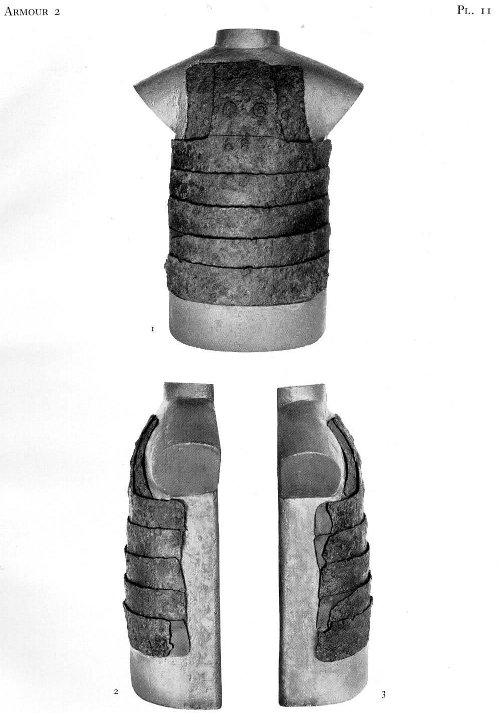
Wisby 2
 Attachment: 46.75 KB Attachment: 46.75 KB
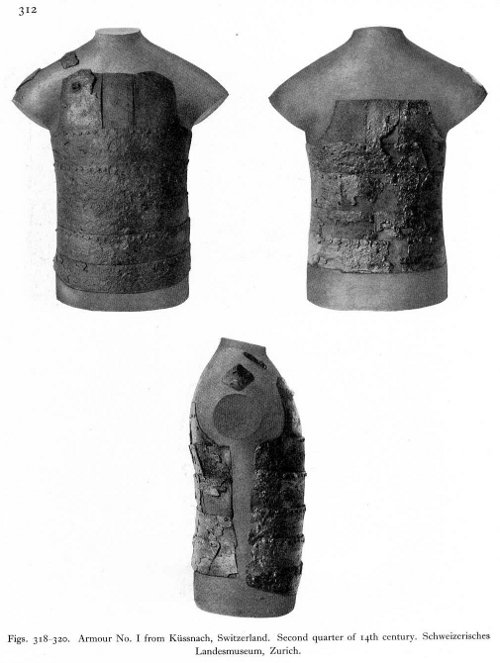
Kussnach 1
 Attachment: 79.73 KB Attachment: 79.73 KB
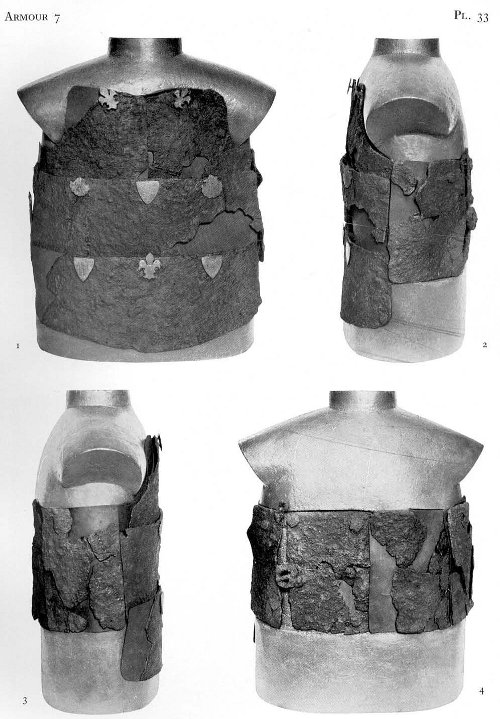
Wisby 7 Note: interpretation of the back may be incorrect. The buckle may be in the center not to the side.
|
|
  |
 |
|
|

